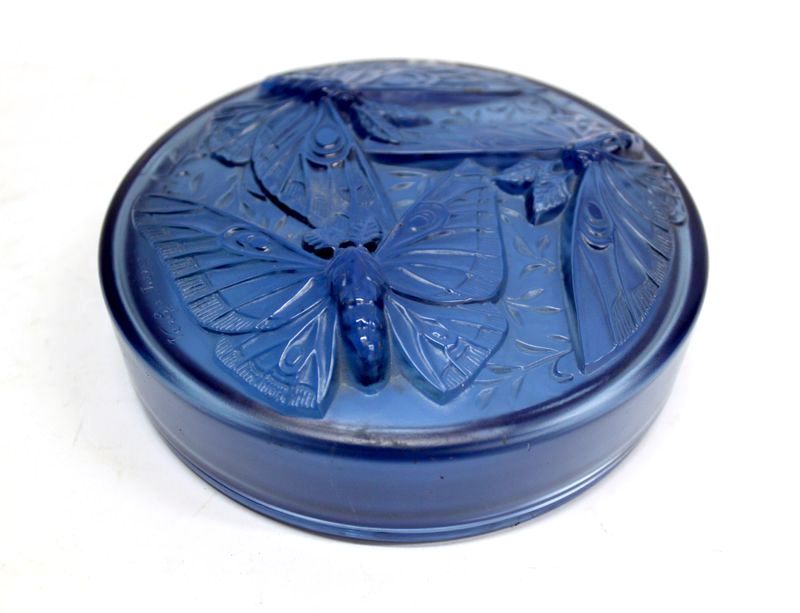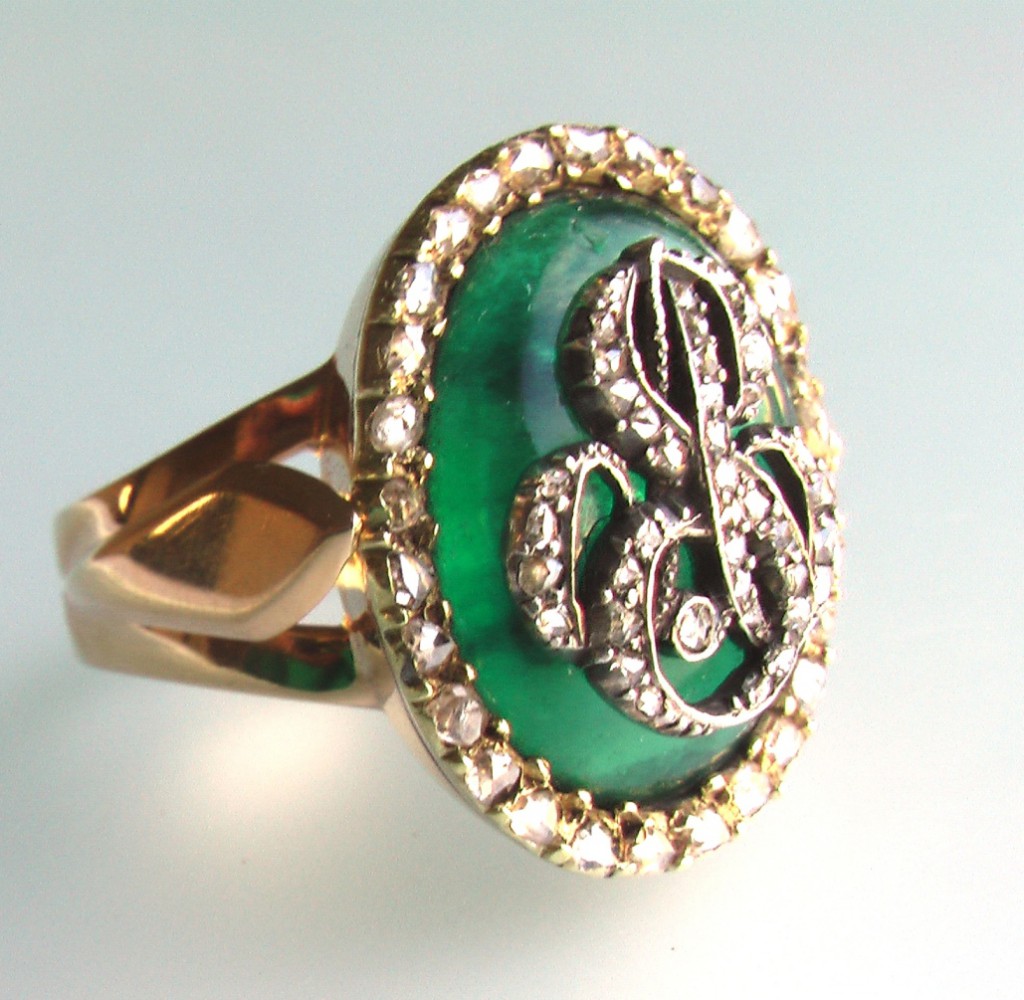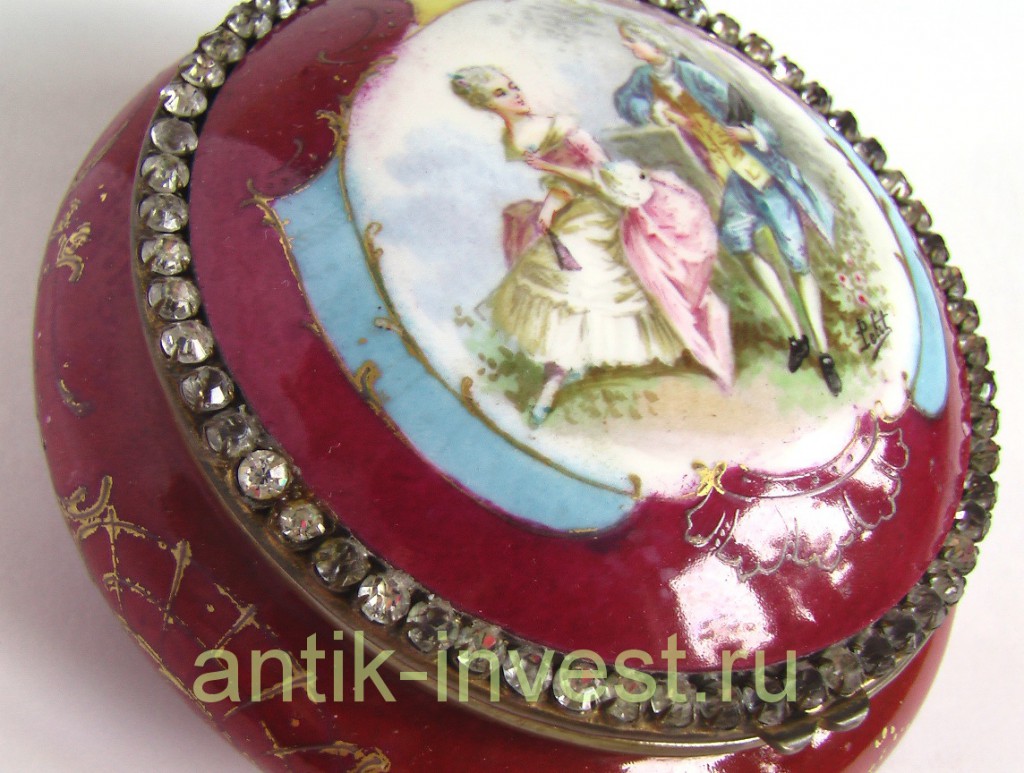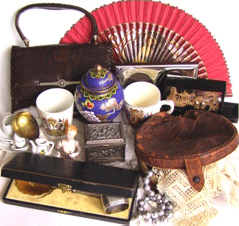шкатулка бомбоньерка стекло Verlys France 5 на 17 см 1920-30е годы, старт 350 евро
Информацию по этому достаточно популярному в Европе бренду на русском я не нашла. На днях переведу.
На шкатулке есть подпись.
Это тематика из серии Рене Лалик, Гале и иже с ними.
Нечастый предмет в таком шикарном состоянии, вроде как дефектов нет.
Most often associated with the Verlys glass name are crystal etched bowls with a three part design. The first piece I ever saw was the Kingfisher bowl in clear glass; it showed a typical Verlys technique with the reverse of the bowl was frosted by acid etching, and the most raised portions of the design were polished by hand to create gleaming clear highlights, resulting in a dramatic three dimensional effect. Three kingfisher birds with exquisite detail molded in high relief swirled around a watery whirlpool background, complete with a few fish. The inside of the bowl was clear flat crystal and the birds formed the feet of the bowl, on the underside. The rim was ground flat, another nice quality touch not found in most manufactured glass today. I was struck by the naturalistic design and the obvious quality of the piece; little did I know it was just the tip of the iceberg.
It’s true that when working with antiques on a daily basis, it’s not a question of if one will become a collector, but rather what one will choose to collect. After working in the business for about 8 months, on Christmas 1999, my husband presented me with box after box to open; each one containing yet another beautiful piece of Verlys glass. This was just the beginning to our collection.
After amassing Verlys for 3 years, my husband and I have around 60 or so pieces, in every color made. A gorgeous dark blue- not quite cobalt, with more of an electric quality- called Directoire Blue was the most popular color produced. And it is lovely. But the opalescent pieces are the most exciting to me, with the fiery glow of moonstones. The smokey topaz color is the most under-rated, I think; it is the exact color of dark topaz and is a hazy dark grey-brown, which has an intriguing subtle quality that appeals to me immensely. Amber was the most highly priced when new, and arguably is the rarest. Dusty rose is a brownish pink lightly applied to the outside of a crystal etched piece, which results in an intriguing subtle quality. All of the pieces made by the American company have a portion of their design frosted by acid, but with some unfrosted portions as well, where a worker applied an acid-resistant solution to the glass (except for the Teardrop bowls).
Verlys was produced in America from 1935 to 1951. The beginning of the French production is not documented (in fact it may appear that they produced a radically different line of cased, blown glass in the early ’20s) but their production ended with W.W.II. From 1955 to 1957 the Verlys molds were leased to the A. H. Heisey company, a producer of elegant glassware in Ohio. Heisey produced a number of pieces, but never signed them except with their sticker. They produced clear & frosted, and Zircon. The Zircon pieces command the highest prices of any color of Verlys produced by any company, especially as they are a cross collectable, and the Heisey collectors are not as spoiled as the Verlys collectors- they’re used to paying dearly for their glass! The unsigned Verlys that is finished is almost always actually Heisey. Heisey pieces don’t have the same detail in the molds, and some of them have the same hand polished high relief parts of the design. Also the glass used by Heisey is a little duller in appearance, when you compare two pieces. Fenton currently uses the Verlys molds from America, although you will never, ever mistake a piece of Fenton for Verlys.
The word Verlys comes from the French region Andelys, where the glass first was produced, combined with verre, the word for glass. The parent company was Holophane glass works, a well-known producer of lamps. They branched out into Deco art glass when it became popular in France, thanks partly to the ground-breaking mass production techniques pioneered by Rene Lalique. The French company produced many different pieces than the American branch. Figurines, lumieres, ashtrays, dinner services, bookends, candy dishes, and the more familiar large charger bowls were among the items produced in France. Many of the molds were shared with the American company, and some American pieces were exclusively American, designed by noted Deco artists Carl Schmitz as well as Victor Schrekengost. I personally don’t find the only-American made items very appealing, but they are extremely collectable. The French pieces and the American pieces are equally well-finished and are similar in value. The French pieces are more often found in color. The colors are slightly different as well; the French Dusty Rose is in fact a dark rose pink in the glass, not applied. And the Amber and especially the Directoire Blue are much lighter in intensity than the American.
All the pieces should be signed as well, in the mold, or with a diamond tipped pen. An interesting side note is that the American etched signature was done mostly by a single worker for many years, according to a former Holophane employee. Some of the first American pieces just have a molded ‘Verlys’ in the center, with no additional diamond pen etched signature (which most American pieces have). The French pieces almost always carry a molded signature, with the word France included. Also, some of the French pieces have just the word Verlys in the center with no France. I can say this without any doubt, as I owned a French Dusty Rose colored Tassel bowl (remember, the French color is remarkably different) until the Nisqually earthquake in ’01. So, there are a few American and French pieces that have identical signatures! Also I own an only French produced piece (so it couldn’t be Heisey) that lacks a signature, a little Poisson decanter stand.
Most of the glass producers in France traded designers back and forth; Pierre D’Avesn designed Rene Lalique’s famous Serpent vase as well as the Tourbillons vase, two of the most highly priced and extremely collectable pieces of “Lalique”. Besides opening his own line in France, he also created many of Verlys’s most famous works, like the highly sought-after Mermaid vase. So in many ways, the biggest difference between those pieces of Verlys and Lalique is the name on the bottom. I own some pieces of R. Lalique glass that lack even the most basic hand finishing that goes into the smallest pieces of Verlys.
The last time I was in Paris, I picked up a Poissons Volantes bowl for about 500 francs- a steal! It was an unusual amber color, much darker than normal, and the bowl had a strange crackled effect on the bottom, and no acid etched portion. It did have the molded Verlys France signature. I assumed at the time it was a factory second, or produced toward the end of the company’s life span. In ’02 I’ve seen a flood of these odd pieces come on to the internet, often with the strange crackled bottoms and no etching, in some very weird colors as well as clear. Through email, I made contact with a former Holophane worker, and he informed me that they were reproductions.
Apparently they are being produced today from the very same molds, and include the molded Verlys signatures. A seller in France who had these repros listed for sale on the internet had ‘fessed up that they were actually new. The crackling is the result of using a very old, rusted mold. I’ve only seen them sold in or from France, so it seems that perhaps it’s a French company reproducing the items. Once you’ve seen one, most of them are pretty easy to spot, with their poor quality. The patterns I’ve seen reproduced so far are Iris, Poissons Volantes, small Anemone dishes, and the Prehistorique bowls so far. The hardest repro to spot is the Prehistorique piece. I would suggest trying to obtain one of the Prehistorique pieces with the acid etched mammoths, rather then the entirely-clear variant. And of course, there’s a lot of Czech Desna glass that is sold as Verlys, the Cherries vase and the Pansy vase among others. They’re for sale brand new all over the Czech Republic.
There are a (very) few publications that can be of help in collecting Verlys. Verlys of America by McPeek is the only book written about Verlys- it was published in 1972 with a revised price guide in 1992. There is one catalogue of from the Holophane France company for reference, dated 1935- 1937. It’s Verlys of France also by the McPeeks, but it doesn’t include commentary or prices, just the catalogue pages. It is an overlooked area, and I personally feel that at some point it will be discovered by collectors at large, especially as Rene Lalique glass from the same time disappears into museums and is out of reach for the average collector. Especially since mass produced Rene Lalique glass and Verlys are of the same high quality. However, I hope that day is far off, so I can keep collecting beautiful and inexpensive Art Deco glass!



